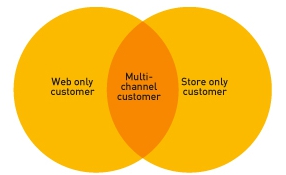Blippar, QR and interactive print media
If you’ve not heard anything about ‘Blippar’, you need to visit this site and learn more. In short, anything that has been ‘blipped’ can be scanned with the app (app store, Android Market [beta] ) and the user is presented with a web link, coupon or even an augmented reality game.
There are some clever uses for this already appearing, with some brands using the technology to extend the printed advert by offering links to other content while others, such as Cadbury, are providing a game to reinforce their brand messaging (Spots vs. Stripes). However, my favourite use has to be the OMEGA advert that lets you see how the watch looks on your wrist. (NB. I couldn’t get the ‘Try on Watch Now’ function to work on Android, which I’m assuming is simply because the Android version is still in Beta). Download the app and ‘blipp’ the image below.
There is obviously cross-over between the functionality of Blippar and QR Codes, and with Blippar definitely providing a better user experience, it’s no surprise that this technology is being seen as a ‘QR Code Killer’.
There has already been a lot written about this, with some good articles linked at the bottom of this blog, and I’m going to add my thoughts:
Firstly – both QR codes and Blippar still require a user to have a smartphone and be prepared to download an app. With smartphone penetration currently at around 28%, the target market for these technologies is still relatively small, so it’s probably too early to see which is favoured by ‘the masses’.
Secondly – it doesn’t matter whether you use QR codes or Blippar, for either technology to be a true success, any content linked to must be relevant and enhance the users experience.
Lastly – I think people who think this will kill off QR codes are perhaps forgetting one of the main advantages of QR codes – simplicity. It’s for this reason that I think we’ll actually see both technologies co-exist. With a better user experience for Blippar users, I wouldn’t be surprised if that does replace QR codes in situations where a company wants to enhance a consumer’s experience, such as providing movie trailers, linking to websites etc. However, QR code’s simplicity means I think it will still have a role to play where there is a very specific action required as an outcome, as demonstrated in the Tesco ‘subway shop’ video at the bottom of this page.
Other articles worth reading: eConsultancy, Cream Global, Nerd Insider & The Grocer
New Look to launch Click-and-Collect
In October New Look will start rolling out click-and-collect to all its 600 stores.
Click-and-Collect isn’t a new concept, and it’s a relatively simple way for a retailer with a physical and online business to begin to integrate the two channels. The reason I wanted to bring attention to this news story is because the kind folk at New Look, in particular their eCommerce Director, Dom McBrien, have released a few facts and figures.
The first target is for click-and-collect to account for 40% of sales over the next three years. With newlook.com being the 3rd most visited site for women’s clothing in the UK, their conversation rate probably won’t need to unrealistically high for that to be achievable.
Secondly, Mr McBrien has stated that from now until the end of the financial year, the click-and-collect service is expected to drive an extra 500,000 people into store. That’s half a million transactions that would otherwise have not involved the opportunity to cross-sell. That’s interesting for New Look as their multi-channel customers spend 2.5x that of a store only customer and 1.7x more than a web only customer.
Also, New Look’s click-and-collect points will use a “hand-held device” to release goods, meaning New Look don’t have to absorb the extra cost of staffing these points.
It’ll be interesting to see if these numbers are achieved, and with New Look having ‘multi-channel development’ as one of their four growth drivers, I wonder what other developments we’ll see from them over the next few years. However, I can’t help but be a bit disappointed with New Look’s description of a multi-channel customer:
There is so much more to multi-channel retailing than simply joining up web only and store only customers, so I’ll give New Look the benefit of the doubt and assume they’re using the Venn Diagram for simplicity on their ‘about us’ page and things are discussed in much more depth behind the scenes.
Convenience is the key
As I’ve touched on already in this blog, as multi-channel retailing continues to grow, we’re seeing a merging of the lines that define various channels. This is of course what multi-channel retailing is all about – providing a consistent customer experience regardless of which channel interactions take place through.
This is something that gives an advantage to traditional retailers over online pure plays. For several years retailers have been trying to find ways to stop losing a percentage of their business to online ‘box shifters’ that provide a cheaper product because of lower overheads. One of the many ways this has been addressed is click and collect, allowing consumers the convenience of online shopping with the ‘safety’ of actually collecting your product from a person in a store (and, depending on model, the transaction actually taking place in store too). It’s with a lot of interest then, that I note House of Fraser are to open a ‘collect store’.
This will provide House of Fraser customers in Aberdeen (House of Fraser have strong online sales in that area and no other physical presence) with a physical location to finish a transaction that started online, whilst House of Fraser doesn’t have the cost associated in opening a full size store. It will be interesting to see how many other retailers follow this, providing a small physical presence to complete transactions started in other channels.
The question is; will we start to see online pure plays open collect stores too? Amazon has just launched collection lockers to provide customers with greater convenience, and it’s not a huge step from that to actually have a small physical high street presence. Then the retail channels merge further still, and the difference between online pure plays and traditional retailers grows ever smaller.
That customer you just lost will cost you £248 per year…
If you’ve stumbled across this blog then chances are you also read the econsultancy blog. On Friday they posted an interesting blog about multi-channel customer service. This is worth 5 minutes of your time and can be found here.
The key point discussed is that customers don’t care how joined up the dots are behind the scenes, they will always see your company as one entity, so if they tweet you a problem, then later phone the customer service desk, they expect the call center staff to know about the earlier tweets.
Reaching a point where you have a single view of your customer regardless of which channel the interaction occurs through is a massive challenge, and whilst companies are generally getting better at selling through and across different channels, there is serious financial incentives for getting multi-channel customer service correct too.
According to the study quoted in the econsultancy blog, 73% of UK consumers have ended their relationship with a company due to poor customer service, and the average cost of a lost customer is £248 per year. Just how much is poor customer service costing you each year?
The lamp with 219 reviews…
I was at an IBM workshop last week, and one topic briefly touched on was the fact that consumers are far more trusting of other consumers feedback than they are of the manufacture’s product description. The fact that a healthy dose of cynicism exists amongst your customers is probably no bad thing, and certainly wont (shouldn’t!) be news to you. Various statistics exist, with some saying that consumer reviews are trusted up to 12 times more than manufacturers descriptions.
But how do you capitalise on this? At it’s most basic level, customers who’ve purchased a product from you should be prompted to write a quick review. Ideally, it shouldn’t matter which channel the customer buys through, but the review should end up where it’s most likely to influence other potential customers. This means that you need to find a way to maintain an element of control on user reviews, as the worst situation for you will be dissatisfied customers making a song and dance about a bad experience, whilst those who had a good experience aren’t being heard. But just how do you maintain control of user reviews?
One company that does provide a ratings/review platform on their website is Argos and the effectiveness of it was highlighted when I needed a new floor lamp. As I’m sure you’re already aware, a lamp is a very simple product, usually comprising of ‘off’ and ‘on’ settings, and the rest being asthetics, yet the lamp I ended up buying had 219 reviews! for a lamp!! I think i’d have probably purchased that lamp without reviews, but for some consumers, that level of feedback will be what pushes them to click the order button.
So next time you’re in a meeting regarding the future of your multi-channel strategy, make sure you ask yourselves “what are we doing to encourage our consumers to become brand ambassadors for us? and how do we keep control of that?”
The crossover between physical and virtual shopping, Part Deux!
Having shown the example of Tesco using QR codes in a subway station, I thought it was worthwhile bringing attention to the fact that Ocado have trialed the same idea in the UK.
There’s a pretty good article in the Telegraph about this, so I wont go over the details again, but what I find most interesting about this is the fact that Ocado have no physical shops, so it’s an interesting example of how online only retailers can start to quite cheaply get some physical product real estate.
Ocado say the aim of this was to increase the number of their transactions that are currently carried out through a smartphone from 15%. I’d love to know if this has helped push that percentage up.
The crossover between virtual and physical shopping
Smartphones have changed the world we live in, so much so that a statement like that is no longer debated, just accepted. Retailers of course, are busy trying to find effective ways to make money from Smartphone users.
At the same time, this new generation of consumers has made the ‘place’ part of the marketing mix more important than ever. So now we’re starting to see a few retailers looking at ways to merge physical and virtual shopping.
I guess the idea is that if you can get your products QR code into the right place at the right time, you increase the chance of getting an impulse buy. Of course, this is dependant on the user being prepared to install your app.
The direction of this is interesting, as ultimately this allows any bit of wall/window/train/bus etc to essentially become product real estate for a retailer. The question is… is this cross over between physical and virtual shopping a new sales channel, or a PR stunt?? Time will tell.

